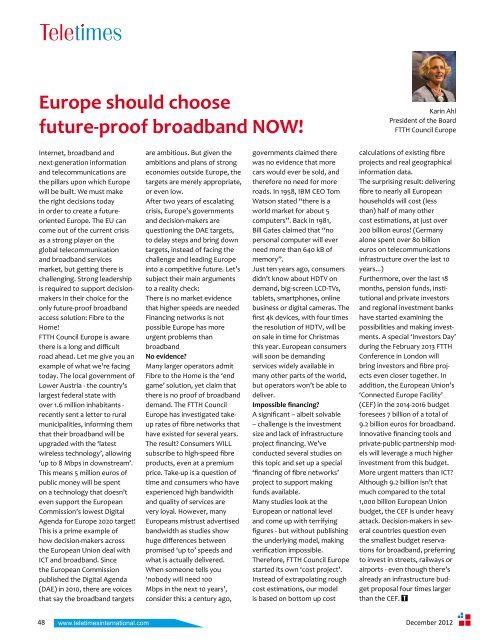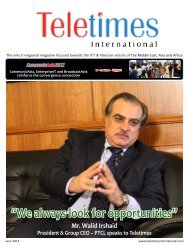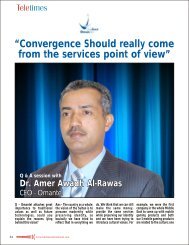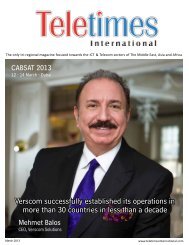ITU Secretary General - Teletimes
ITU Secretary General - Teletimes
ITU Secretary General - Teletimes
You also want an ePaper? Increase the reach of your titles
YUMPU automatically turns print PDFs into web optimized ePapers that Google loves.
Europe should choose<br />
future-proof broadband NOW!<br />
Karin Ahl<br />
President of the Board<br />
FTTH Council Europe<br />
Internet, broadband and<br />
next-generation information<br />
and telecommunications are<br />
the pillars upon which Europe<br />
will be built. We must make<br />
the right decisions today<br />
in order to create a futureoriented<br />
Europe. The EU can<br />
come out of the current crisis<br />
as a strong player on the<br />
global telecommunication<br />
and broadband services<br />
market, but getting there is<br />
challenging. Strong leadership<br />
is required to support decisionmakers<br />
in their choice for the<br />
only future-proof broadband<br />
access solution: Fibre to the<br />
Home!<br />
FTTH Council Europe is aware<br />
there is a long and difficult<br />
road ahead. Let me give you an<br />
example of what we’re facing<br />
today. The local government of<br />
Lower Austria - the country’s<br />
largest federal state with<br />
over 1.6 million inhabitants -<br />
recently sent a letter to rural<br />
municipalities, informing them<br />
that their broadband will be<br />
upgraded with the ‘latest<br />
wireless technology’, allowing<br />
‘up to 8 Mbps in downstream’.<br />
This means 5 million euros of<br />
public money will be spent<br />
on a technology that doesn’t<br />
even support the European<br />
Commission’s lowest Digital<br />
Agenda for Europe 2020 target!<br />
This is a prime example of<br />
how decision-makers across<br />
the European Union deal with<br />
ICT and broadband. Since<br />
the European Commission<br />
published the Digital Agenda<br />
(DAE) in 2010, there are voices<br />
that say the broadband targets<br />
are ambitious. But given the<br />
ambitions and plans of strong<br />
economies outside Europe, the<br />
targets are merely appropriate,<br />
or even low.<br />
After two years of escalating<br />
crisis, Europe’s governments<br />
and decision-makers are<br />
questioning the DAE targets,<br />
to delay steps and bring down<br />
targets, instead of facing the<br />
challenge and leading Europe<br />
into a competitive future. Let’s<br />
subject their main arguments<br />
to a reality check:<br />
There is no market evidence<br />
that higher speeds are needed<br />
Financing networks is not<br />
possible Europe has more<br />
urgent problems than<br />
broadband<br />
No evidence?<br />
Many larger operators admit<br />
Fibre to the Home is the ‘end<br />
game’ solution, yet claim that<br />
there is no proof of broadband<br />
demand. The FTTH Council<br />
Europe has investigated takeup<br />
rates of fibre networks that<br />
have existed for several years.<br />
The result? Consumers WILL<br />
subscribe to high-speed fibre<br />
products, even at a premium<br />
price. Take-up is a question of<br />
time and consumers who have<br />
experienced high bandwidth<br />
and quality of services are<br />
very loyal. However, many<br />
Europeans mistrust advertised<br />
bandwidth as studies show<br />
huge differences between<br />
promised ‘up to’ speeds and<br />
what is actually delivered.<br />
When someone tells you<br />
‘nobody will need 100<br />
Mbps in the next 10 years’,<br />
consider this: a century ago,<br />
governments claimed there<br />
was no evidence that more<br />
cars would ever be sold, and<br />
therefore no need for more<br />
roads. In 1958, IBM CEO Tom<br />
Watson stated “there is a<br />
world market for about 5<br />
computers”. Back in 1981,<br />
Bill Gates claimed that “no<br />
personal computer will ever<br />
need more than 640 kB of<br />
memory”.<br />
Just ten years ago, consumers<br />
didn’t know about HDTV on<br />
demand, big-screen LCD-TVs,<br />
tablets, smartphones, online<br />
business or digital cameras. The<br />
first 4k devices, with four times<br />
the resolution of HDTV, will be<br />
on sale in time for Christmas<br />
this year. European consumers<br />
will soon be demanding<br />
services widely available in<br />
many other parts of the world,<br />
but operators won’t be able to<br />
deliver.<br />
Impossible financing?<br />
A significant – albeit solvable<br />
– challenge is the investment<br />
size and lack of infrastructure<br />
project financing. We’ve<br />
conducted several studies on<br />
this topic and set up a special<br />
‘financing of fibre networks’<br />
project to support making<br />
funds available.<br />
Many studies look at the<br />
European or national level<br />
and come up with terrifying<br />
figures - but without publishing<br />
the underlying model, making<br />
verification impossible.<br />
Therefore, FTTH Council Europe<br />
started its own ‘cost project’.<br />
Instead of extrapolating rough<br />
cost estimations, our model<br />
is based on bottom up cost<br />
calculations of existing fibre<br />
projects and real geographical<br />
information data.<br />
The surprising result: delivering<br />
fibre to nearly all European<br />
households will cost (less<br />
than) half of many other<br />
cost estimations, at just over<br />
200 billion euros! (Germany<br />
alone spent over 80 billion<br />
euros on telecommunications<br />
infrastructure over the last 10<br />
years...)<br />
Furthermore, over the last 18<br />
months, pension funds, institutional<br />
and private investors<br />
and regional investment banks<br />
have started examining the<br />
possibilities and making investments.<br />
A special ‘Investors Day’<br />
during the February 2013 FTTH<br />
Conference in London will<br />
bring investors and fibre projects<br />
even closer together. In<br />
addition, the European Union’s<br />
‘Connected Europe Facility’<br />
(CEF) in the 2014-2016 budget<br />
foresees 7 billion of a total of<br />
9.2 billion euros for broadband.<br />
Innovative financing tools and<br />
private-public-partnership models<br />
will leverage a much higher<br />
investment from this budget.<br />
More urgent matters than ICT?<br />
Although 9.2 billion isn’t that<br />
much compared to the total<br />
1,000 billion European Union<br />
budget, the CEF is under heavy<br />
attack. Decision-makers in several<br />
countries question even<br />
the smallest budget reservations<br />
for broadband, preferring<br />
to invest in streets, railways or<br />
airports - even though there’s<br />
already an infrastructure budget<br />
proposal four times larger<br />
than the CEF.<br />
48 December 2012<br />
www.teletimesinternational.com
















